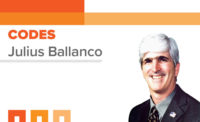Editor’s note: The International Code Council will post a Call for Committee on iccsafe.org for the 2024 Code Cycle in February 2023 with an application deadline of June 1, 2023.
In the past, I never really thought about codes and where they originated from. I had a discussion with a fellow engineering colleague recently about a small code section which evolved into a larger conversation about codes in general and the differences between building code requirements and an engineer’s design. As the discussion evolved, I found out that he did not understand how building code changes are made and that anyone can have a voice in maintaining the safety of our work. In short, the code is not a design manual.
Building codes and standards are the foundation of safe and sustainable communities. But what exactly are building codes built on? In the U.S., we have reliable development processes that allow all interested parties and stakeholders — from manufacturers to professional engineers to contractors to building safety professionals — to participate in developing and updating building codes. All are encouraged to come forward and make their voices heard. But it is the final step in the code development process that gives the last word to the group known as governmental members.
Let’s look at how building codes are developed.
The government consensus process for developing building safety codes is tried and true
For most of my tenure, I’ve participated in the International Code Council’s code development process.
The process looks like this:
- Changes to the codes are proposed;
- Those codes are then reviewed by committees of experts at the Committee Action Hearings where anyone is given the opportunity to present an argument for or against a proposal;
- All interested parties submit public comments on the committee decisions;
- The comments are considered and voted upon by eligible ICC members during the Public Comment Hearings; and
- Finally, those code changes are reviewed and voted upon by eligible government officials during the Online Governmental Consensus Vote.
This is known as the governmental consensus process, and it has been producing safe, science-backed life safety codes and standards for many decades. As you can see, government officials have the last word in this process. Why?
Here are a few reasons:
- First, and perhaps most importantly, they have no financial interest at stake. In other words, where a manufacturer has a financial incentive to get their product(s) recognized in the codes, or a contractor may have an interest in getting a specific installation method approved, a government official has absolutely zero financial interest in the outcome of a new code;
- Public safety is their first concern, and their decisions on codes are made through that filter, which is the same filter they apply every day when enforcing codes and standards, or approving alternate materials and designs not addressed in the codes;
- They’re intimately familiar with the challenges and goals of the local jurisdictions and therefore understand what makes the most sense and what it will take to implement code changes; and
- The codes are not a design manual; they are a minimum safety standard. They are not intended to be used in lieu of designs that are certified by professionals. Instead, design engineers should reference the minimum standard while designing to meet the specifics of their project(s).
Everyone deserves a voice when developing building codes
Government officials have the final say on what gets amended in the code, but this is still a democratic process where all voices are welcomed. In this system, everyone can share their voice and contribute to the process.
Everyone has an equal opportunity to participate in this process by submitting code change proposals and then advocating for and debating those proposals in an open, public forum. In addition, applying to serve on the Code Council’s Code Development Committees is open to all. Committee members donate their time on a volunteer basis. Professionals from all related fields including design professionals, tradespeople and members of the building and construction communities are encouraged to apply.
Governmental members: More than just code officials
Governmental member voting representatives are appointed by their local jurisdictions to represent them in the process, and they typically hold one of the following positions or a combination:
- Agency heads;
- Code officials;
- Inspectors (e.g., building, plumbing, mechanical);
- Professional engineers; and
- Public health officials.
Building code updates and the latest building science
While having a proven process is important, we must also consider the outside variables that impact the built environment.
As technologies, building materials and best practices evolve, it is vital for existing codes to be updated on a regular basis to maintain quality and ensure the latest building science is incorporated. As good stewards of building safety, the Code Council initiates a regular process that has each of the International Codes (I-Codes) being updated on a three-year cycle, resulting in them often being the first codes to include new technologies, innovations and provisions.
For example, the 2021 International Plumbing Code included new provisions around PVC (polyvinyl chloride) and ABS (acrylonitrile-butadiene-styrene) push-fit for drain, waste and vent fittings. During the code development process, it was acknowledged that each type of pipe fitting has its benefits — ABS pipes can absorb a higher shock and are better at handling the extreme cold, while PVC pipe is more flexible. It was also found that these fittings will have a direct effect on the construction cost and the use of this push-fit joining method would eliminate the need for solvent cementing.
These updates provide the opportunity for more flexibility and in many cases, cost savings, which can really add up.
Model building codes must be based on communities’ best interests
The I-Codes represent communities’ best interests and are intended to be able to be understood and followed by contractors, design engineers and the public. Codes are not intended to be used as the design engineer’s manual for what to do — whether it be prescriptive, or performance-based. While all projects and jobs differ, when they do require a design engineer’s input, there are appropriate procedures that the engineer may proceed with to provide an alternative engineered design approach. This is the way that the codes allow specific engineered designs without the need for direct adherence to the codes’ specificity. It is provided to allow the engineer a design approach based on technical science.
As society continues to advance, the needs of communities are changing. For example, as more states and local jurisdictions place a priority on creating sustainable and resilient communities, many have set ambitious goals to reduce energy use and the greenhouse gases associated with commercial and residential buildings. To help jurisdictions reach these goals, modern buildings codes and standards rely on the democratic process to not only ensure they meet their needs, but also that they have the support required to get those codes adopted.
Building safety professionals from all corners of the industry want the same thing — safe, resilient and affordable structures that support the health and well-being of residents and occupants. The Code Council is the steward of the democratic code development process and helps bring all stakeholders together to create modern, cost-effective building codes. However, as in any democratic process, the onus is on all interested parties and stakeholders to participate, so that every opinion is heard.



